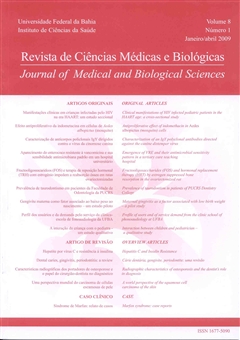Profile of users and of service demand from the clinic school of phonoaudiology at UFBA
DOI:
https://doi.org/10.9771/cmbio.v8i1.4376Keywords:
Phonoaudiology – Epidemiology – Public Health – PhonoaudiologyAbstract
This study verified the profile of users and of service demand from the clinic school of phonoaudiology at ufba, and contribute to researchers in Collective Health related to SLP area. This study was developed by reviewing clinic records of individual that began using the Speech and Language Pathology (SLP) training clinic service between 2004 and 2007. It was collected clinic and socio-demographic data such as: age, gender, scholarity, occupation, average family income, origin of referral, time that took to start being attended and which of the SLP areas the diagnostic hypothesis was placed on. Most of the 210 individual were referred by health professional (49%). The majority patients were male (51,4%), the range of age between 0 and 12 years old was the most frequent (52%). 64,8% of the people presented one reason to look for the service. 49,3% (75) of the people were waiting time to start to attend the service about 6 months. The specific areas of SLP which had more diagnostic hypothesis on were Language (52,4%), Oralfacial Mofunction (31,4%) and Voice (19%). The profile of individual studied on this research showed a population composed mostly of males there are between 0 and 12. Most of the referral were made by health professionals. Most of the patients presented just one reason to look for the service and the waiting time to be attended was about 6 months. The SLP areas that had more diagnostic hypothesis were Language, Orofacial Miofunction followed by Voice.Downloads
Download data is not yet available.
Downloads
Published
2009-04-30
How to Cite
Costa, R. G. da, & Souza, L. B. R. de. (2009). Profile of users and of service demand from the clinic school of phonoaudiology at UFBA. Journal of Medical and Biological Sciences, 8(1), 53–59. https://doi.org/10.9771/cmbio.v8i1.4376
Issue
Section
ORIGINAL ARTICLES
License
The Journal of Medical and Biological Sciences reserves all copyrights of published works, including translations, allowing, however, their subsequent reproduction as transcription, with proper citation of source, through the Creative Commons license. The periodical has free and free access.


